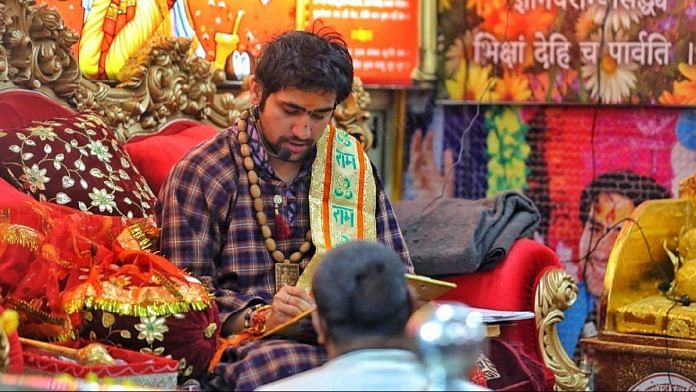There’s a train that runs between Bhopal and Khajuraho. It doesn’t stop at Bageshwar Dham, but that won’t deter the passengers. They just pull the chain and jump out in thousands in a stampede-like rush — to reach the Balaji temple and book a meeting with Dhirendra Krishna Shastri, the latest ‘miracle-maker’ of Madhya Pradesh.
Over a hundred autorickshaws wait outside the Dham on Tuesdays and Saturdays to ferry these desperate devotees to the ashram of the rising new star among India’s vast, ever-growing spiritual-political-industrial complex. They don’t care about the grand rationalist and mentalist challenges to Dhirendra Shastri or the daily TV news controversies that surround him. In fact, all the criticism actually feeds his godman mythology.

They just make the lines outside his ashram longer.
At the Balaji temple, people queue up to drop a piece of paper — with their names, phone numbers and addresses — in a box. And wait for months, even a year, till they get a phone call to meet the 25-year-old ‘baba’.
But critics say that Shastri is on the run from the Maharashtra rationalists these days.
His tall claims were ruptured in Nagpur where he had gone for Ram Katha from 5-13 January. Shastri was to hold a darbar on 7-8 January to display his ‘miraculous’ powers to his doting devotees.

Then the unthinkable happened. Rationalist Shyam Manav challenged him to display his “chamatkar” on stage. He volunteered to bring 10 random people with him so that Shastri could correctly name their fathers and give their home addresses as he has claimed he can do with the help of Balaji. Manav also filed a police complaint against Shastri in Nagpur under the Anti-Superstition and Black Magic Act.
Shastri cut his losses, cancelled the events, and left the city the very next day. Such challenges are rare in India where non-believers just turn the other way when ‘babas’ hold sway. But Maharashtra’s recent anti-superstition law has emboldened rationalists who belong to assassinated Narendra Dabholkar’s group. Dabholkar, who was gunned down in Pune in 2013, had founded the Maharashtra Andhashraddha Nirmoolan Samiti, which fights superstition and their peddlers.
“Our challenge is still open. We have seen a video of Shastri claiming to know the name, address, ailments, and father’s name of people. This is not scientifically possible,” says Manav, founder of Akhil Bharatiya Andhashraddha Nirmoolan Samiti.
He claims that over the past 40 years, the Samiti has exposed thousands of ‘godmen’ who are adept at chicanery. “But if he performs on a public forum, we will apologise and shut our anti-superstition organisation,” Manav adds.
Others joined in too. It appeared for a brief while as if all the critics were ganging up.
India’s first woman mentalist Suhani Shah from Rajasthan has called Shastri out on almost every TV news channel debate.
“Fear has become a business in India. I have nothing against these godmen, but what they show as supernatural power is an art. There is no supernatural power at play,” Shah told ThePrint over the phone.
The godman beat a hasty retreat.
Also read: From gaon to Golf Links — Modern India is still under the spell of black magic
Maharashtra to Madhya Pradesh
But once Shastri was back among his believers in Bageshwar Dham, his carefully constructed guru-verse was safe again. Seated on a crimson sofa placed on a raised platform, wearing a long red-and-black robe with neck beads and Hanuman pendant, he doled out predictions after ‘consulting’ with Balaji. The fawning crowd circled around him, holding on to every word.
“Your husband committed a crime. Balaji is telling me. Am I right?” Shastri thundered on the microphone while scribbling on a piece of paper, his feet resting on a soft white mat.
The woman sitting at his feet looked up anxiously. But she could draw no comfort from Shastri’s predictions.
“His case is strong. He will go to jail.”
The woman bent her head in submission, pleading before him to perform a miracle.
Shastri muttered something under his breath while looking at a photo of Balaji.
Then the grandstanding resumed.
“Balaji told me that your husband will get bail. Go. Be happy now. Bolo Seeta Ram.”
The crowd shouted “Seeta Ram” in chorus raising their hands. Shastri handed over the paper with illegible writing to the woman.
The seemingly grateful woman left with a peaceful smile.
After every ‘prediction from Balaji’, Shastri handed out ash to the devotee.
At his darbar, a huge wall with iron railings separates him from the petitioners.
Thousands of frenzied followers who can’t find space inside the darbar climb the wall to peer through the windows to catch a glimpse of Shastri. They angle their phones through the window grilles to take photos, all the while shouting in his praise.

“The godmen are reflections of power. It allows people to be a part of that power of the god they believe in,” said Goa-based German anthropologist Katharina Poggendorf-Kakar, author of Women in India: A Life Between Repression and Resistance, who is researching India’s godmen phenomenon for her first novel.
“India is known for a surfeit of godmen coming every few years and later vanishing in thin air.There is a demand, a wish, for godmen in India by the believers, for someone who has the power which they don’t have.”
Also read: State anti-superstition laws not enough. India needs a central law, focus on victim not crime
Man behind the ‘godman’
Who gets to meet Shastri is a mystery too. It comes down to luck or fate. Young girls are assigned the task of dipping their hands into the box and randomly drawing out folded chits where petitioners have written their names and contact details. Shastri’s team then gets to work, contacting petitioners and fixing appointments.
His followers call it ‘god’s calling’ whenever they get that call to meet Shastri. They are given detailed instructions about the offering to be made at the temple — a coconut draped in cloth. The colour of the cloth is significant. Red signifies issues with childbirth, yellow means problems related to marriage, and black is for evil spirits.
“It’s not me but Balaii who is offering you help. I am doing nothing. Balaji is making me do all this,” said Shastri as he raised his finger in the air. His body language gives the impression that some divine power is entering him as he writes another note. His acolytes inside and outside the darbar erupt in cheer.
Shastri then steps out for selfies with followers.
It isn’t just him, but the adulation extends to his ancestral village, his mother and brother, too. Barely a kilometre from Bageshwar Dham is the village Gadha in Rajnagar tehsil of Madhya Pradesh’s Chhatarpur district where Shastri grew up.
In Gadha, almost every house is a sturdy cement structure. But Shastri’s house is the grandest. It doesn’t have a nameplate, but a poster on the boundary wall says it all. The one-storey house is currently being renovated but that doesn’t stop hundreds of devotees from gathering outside. A constable from the local police station stands guard. Shastri has hired a personal security officer and two private guards as well.

Many of his devotees take selfies next to the gate. When they get too close, the guards push them back. A sighting of Shastri or even his mother is an event. The crowd roars and cheers, much like the legion of Shah Rukh Khan fans waiting outside his Mumbai house, Mannat.
Social media has also played a huge role in Shastri’s meteoric rise. Most of his followers and devotees have discovered him on YouTube. His darbars held on Tuesday and Saturday are also recorded and uploaded for his fans.
“I first saw Shastri ji on YouTube. It felt as if he is the god who has come in Kali Yuga to restore Hindu religion and help people who are in misery,” said 24-year-old Rohit who had come from Uttar Pradesh.
Apart from the darbars, Shastri also uploads videos of the ‘miracles’ he has performed. Some of his videos have over a million views.
Naresh Yadav, 37, from Deogaon in Odisha has been rolling on the road for the past five days — it will take him a week to reach Bageshwar Dham but he is determined not to walk.
“After meeting him, all my wishes will be fulfilled. I want to offer him my respect by rolling on the road till I reach his darbar,” says Yadav, who makes a living doing odd jobs.

Ravi Kumar, 35, a police constable from Uttar Pradesh, has come with his family to meet Shastri. But he doesn’t want to leave without a blessing from Shastri’s mother either.
“I want to touch the feet of the mother who gave birth to such a man. I will stand whole day till she comes out,” said Kumar.
Shastri’s mother Saroj doesn’t disappoint the devotees. She appears on the first floor terrace of the house to give darshan to the followers. She raises her hands, in a move uncannily similar to the late Shiv Sena leader Bal Thackeray.
Five kilometres from their house, Shastri’s cousin Dinesh Garg, too, performs ‘miracles’ and holds darbars in a room in his house. He may not be as famous as Shastri, but he is the competition. The tussle between them is fodder for village gossip. Villagers say the two don’t get along.
“While Shastri prays to Lord Hanuman, Garg follows Lord Ram. Those who can’t meet Shastri come to meet Garg,” a villager said.

Garg, too, uses a parcha (paper) to convey Lord Ram’s words to those who plead their case to him. He rolls his eyes and tugs at his ears to indicate that he is communing with divinity. And like Shastri’s scrawl, his writing too is difficult to decipher.
A constable dressed in his police uniform entered the room with a garland and a box of sweets. Assigned to the nearby Orchha police station, TR Namdev had consulted Garg when a 13-year-old boy went missing. When the missing child was finally traced a month ago, the constable credited the ‘godman’ for his success.
“Maharaj (Garg) gave me the parcha saying that the boy will return in 15 days. And it happened. The boy returned home after 11 days. Baba changed the boy’s mind. Isn’t it a miracle?” Namdev asks.

People inside the room cheered in unison.
Garg denied rumours of bad blood between him and his more famous cousin. “I don’t hold any grudge against my brother. We are on good terms. It’s just that I have never wanted media attention. The more popular I become, the more people will show up and I won’t be able to cater to all of them,” Garg said later, sitting on a chair next to a Neem tree.
But he did take a dig at Shastri’s legion of devotees. “I don’t want popularity, only the good of my people,” Garg said.
Also read: It’s all in the stars: Indian astrological texts are full of queer predictions for mortals
Fear and economy, thriving
The presence of two ‘godmen’ has proved to be a boon for Gadha village’s economy.
People have started subletting their rooms to followers. A 70-year-old woman, who has three rooms to spare, rents them out for Rs 600, Rs 1,000 and Rs 1,500.
Local real estate agents say that the price of land has nearly doubled — from Rs 1,200 per sqm to Rs 2,200 per sqm.
The road to Bageshwar Dham, which is located on the hillocks at the confluence of Ken and Betwa rivers, is dotted with tea stalls and dhabas, low-budget rentals that cater to the thousands of devotees.
At the market outside the Dham, several small shops have come up selling god-like portraits of Shastri, and rings and lockets with his photo. “I used to come here before for darshan but as the crowd swelled, I opened a slipper shop. Everyone who comes to the Dham stays there for at least two days. So I have hundreds of customers coming to me every day,” said Kishor Sidh from Tikamgarh district. The monthly rent for his shop is Rs 8,000, but it’s still a lucrative business.

Owners of commercial establishments within 100 metres of the Dham ‘donate’ the rent amount to the Bageshwar Dham Welfare Committee.
Amid the thriving local economy, there are allegations that Shastri has acquired properties illegally. Many property owners in the area alleged that four houses were razed to make space for a parking lot. Others claim Shastri has acquired land forcefully, though there are no police complaints or FIRs.
“We have benefitted from his presence, but we are also scared of his power and influence,” a villager said.
Another villager recounted that the boundary wall of his house was demolished when his elderly parents were still in the house. “No one will tell you. There is an absolute gunda system here. If you open your mouth, anything can happen to you,” he added.
Also read: Who is behind Madhya Pradesh’s ‘Bulldozer baba’? Not BJP or RSS, it’s the Congress
Election, vote, politics
Shastri has not gone unnoticed by Madhya Pradesh’s BJP government. His activities are being monitored closely, a source in the inner circle of chief minister Shivraj Singh Chouhan said.
“We have not found anything problematic in his work. Whether he is a chamatkari or not is secondary, but for now, he is not involved in anything illegal. The government is keeping track of all his activities,” said the source.
With Madhya Pradesh scheduled to go to polls this year, the BJP government is treading carefully.
“Elections are coming and the state government is looking at translating his followers into a vote bank. So they will not disturb him till the elections,” the source added.

Several BJP leaders have come out in support of Shastri after his remark to his followers, urging“people of Sanatana Dharma” to unite. “Today we need to make Hindu Rashtra. You support me and I will give you Hindu Rashtra,” Shastri said last month at a recitation of Ram Katha in Raipur, Chhattisgarh. BJP leader Kapil Sharma held a demonstration in Shastri’s support and called upon seers to speak up for him.
Madhya Pradesh home minister Narottam Mishra, whom Shastri calls “Babbar Sher”, is one of the ardent followers and visits him regularly.
The opposition Congress also openly supports Shastri. The party’s Raipur West MLA Vikas Upadhyay recently called Shastri a god-like figure.
“When BJP is openly supporting Shastri, Congress cannot hurt the sentiments of thousands of people who are coming to him. Elections are coming in November and Shastri will play an instrumental role in turning the tables,” said a Madhya Pradesh Congress leader, not willing to be identified.
Samajwadi Party leader Ramdayal Prajapati, former MLA who quit the BJP in 2016, described Shastri as the BJP’s ‘brainchild’.
“If he has cured cancer patients, why doesn’t he show them to us? We should shut down all the hospitals and everyone should go to him,” Prajapati said.
For rationalists like Mukta Dabholkar (the daughter of Narendra Dabholkar) and anti-superstition organisations such as Maharashtra Andhashraddha Nirmulan Samiti, ‘godmen’ like Shastri are a systemic problem—they prey on the gullible and naive. Mukta argues that it’s easier to not question one’s belief systems.
“You feel that you don’t have to question your belief system. The longer your are connected with something, the more difficult it becomes to question yourself and your whole life to realise that you have been believing in the wrong thing. This is the psychological explanation for it. So it’s easy to reject the criticism,” said Katharina, senior fellow at the Center for the Study of World Religions at Harvard University.
“You question the evidence and not the belief.”
(Edited by Prashant)



